- What Is An Embedded System?
- Classification Of Embedded Systems Based On Performance And Functional Requirements
- Classification Of Embedded Systems Based On Micro-controller/ Complexity
- Classification Of Embedded Systems Based on Generation
- Classification Of Embedded Systems Based on Deterministic Behavior
- Classification Of Embedded Systems Based On Triggering
- How Do Embedded Systems Work?
- Advantages & Disadvantages Of Embedded Systems
- Applications Of Embedded Systems
- Embedded System vs. Server vs. Workstation
- Conclusion
- Frequently Asked Questions
Classification Of Embedded Systems In 5 Ways (With Applications)
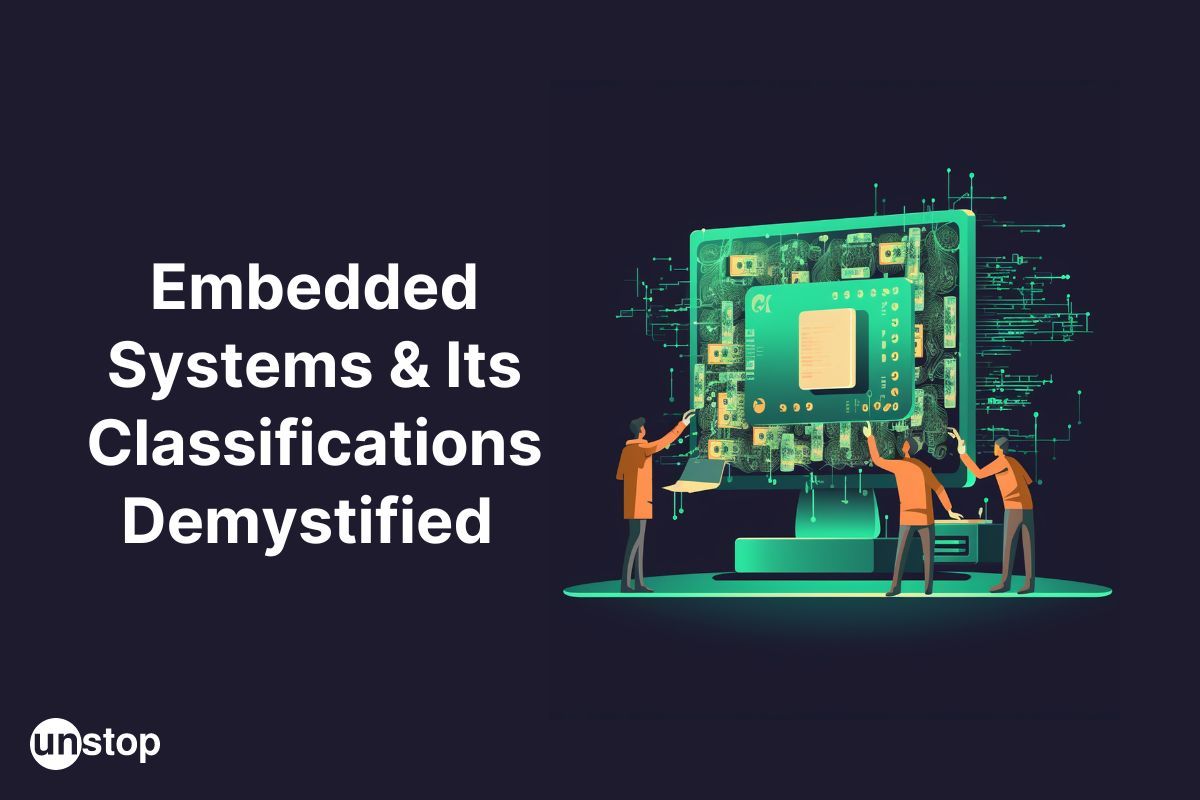
Embedded systems are complex pieces of technology designed to perform specific tasks. They are usually made up of different components, and the capabilities vary greatly depending on the nature of these components.
Generally speaking, the classification of embedded systems can be done across several categories-
- Hardware resources (8-bit processors, digital signal processors, multicore processors),
- Reconfigurable processors (performance of microcontroller 16/32-bits),
- User interfaces (smart devices with user inputs), as well as
- Executable codes for ATM machines or other applications.
Each category requires its range of knowledge and skills to operate efficiently. This includes the understanding of how each component works to choosing the best type for a particular task. With so many options available, developers need to understand which approach is most suitable for them when operating an embedded system. It is important to be able to figure out which embedded system works according to one needs to minimize time spent debugging errors caused by incorrect implementations during development stages. So, in this article, we explore the concept of embedded systems and the classification of embedded systems with applications in detail.

What Is An Embedded System?
Embedded systems are special-purpose computing machines that perform one or a few dedicated functions. They typically contain hardware and software components, including microprocessors, memory chips, input/output (I/O) devices such as keyboards and displays, digital signal processors (DSPs), application-specific integrated circuits (ASICs), real-time operating systems (RTOSes) for scheduling tasks within the system as well as firmware embedded in programmable nonvolatile memory. These systems can interact with their environment through sensors and actuators to provide control over physical processes.
Real-world examples of embedded systems include:
- Automobiles - Most modern cars have several computers controlling various aspects of performance. For example, navigation systems, telematics, cruise control, etc.
- Industrial Machinery - Robots on factory floors use embedded computers to read instructions from work orders.
- Avionics - The complex avionic suites used by commercial aircraft rely heavily on advanced embedded computer controllers for navigation and guidance.
- Home Appliances - Washers & dryers often incorporate simple controllers to regulate temperature during a cycle.
- Security Systems - Computers are used in burglar alarm systems to monitor and process sensor data.
The Evolution Of Embedded Systems
- Early embedded systems were used in industrial applications, such as machine control and factory automation.
- Embedded systems underwent a rapid expansion with the introduction of PCs in the 1980s due to their low cost and increased processing power compared to traditional mainframes.
- The emergence of powerful microprocessors allowed for even more versatile devices that could be found in everyday products, such as printers, microwaves, or other appliances.
- This enabled companies to add features not previously available on these items at an affordable price-point for consumers.
- As technology advanced further into the 21st century, computing resources became smaller and cheaper, allowing almost any physical object (from a car's ECU up through batteries) can incorporate some processor or logic circuit controlling its operation.
- This helped lead to what has been termed The Internet Of Things (IoT).
- And advancements are still being made today. Especially with artificial intelligence (AI) based algorithms allowing computers/machines equipped with sensors & processors to glean insight from collected data. Thus making them capable of recognizing patterns, all while enabling self-optimization regarding system operations.
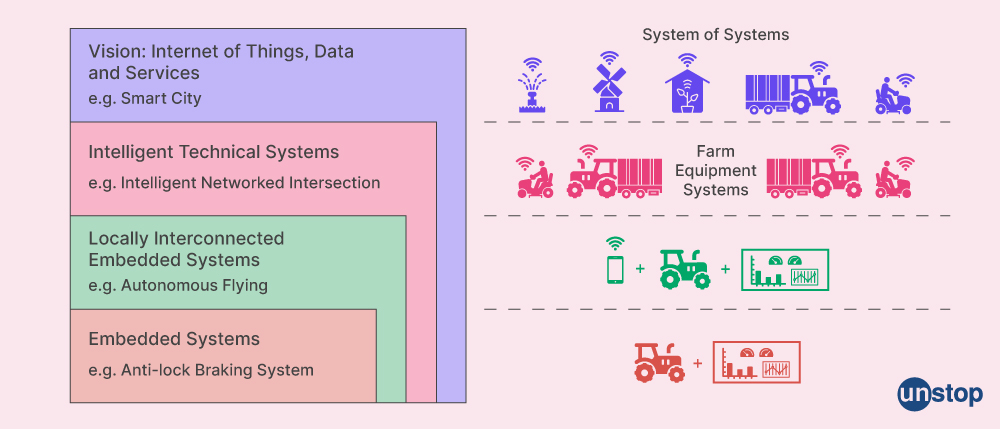
Features Of Embedded Systems
- Small in size: Embedded systems are designed to be small and compact. They usually have a dedicated microprocessor or embedded controller at their heart, ranging from 4-bit machines for simple functions up to 32-bit processors running complex applications such as controlling an aircraft's flight system.
- Low power consumption: Another important feature of embedded systems is their low power requirements, i.e., they need less energy than full computers with large hard drives and processing cores. This makes them ideal for portable devices or those deployed in areas where electricity may not be easily accessible on demand.
- Cost-effectiveness: Because of the specialized nature of these designs, they tend to cost much less than traditional computing solutions due to the simplicity required by most tasks that they perform when compared against desktop-based alternatives. This makes it possible for many companies, organizations, and individuals who don't possess huge budgets to access high-quality technology that otherwise would remain out of reach due to its costs.
- Customized functionality: Often, commercial off-the-shelf (COTS) products may not fulfill all our needs. This gives rise to the need for custom programming and hardware modifications, often undertaken through embedding new hardware components within certain systems and adding value-related features. This ability to customize functionality helps make a system a healthier fit for fulfilling certain tasks.
- Reliability: One of the key features of embedded systems is their relative reliability, and this comes from being designed for a limited set of purposes. There are fewer components in an embedded system than more standard computers, so it's less likely to fail due to hardware compromises. In addition, most designs have error-checking mechanisms built into them, ensuring that data is not compromised by incorrectly formatted inputs or broken connections with other devices.
Embedded Systems Basics: Components
Embedded systems perform specific tasks within a larger system or machine. As mentioned before, they can be found in various industries, including automotive, healthcare, industrial automation, and more. The common components of embedded systems include:
- CPUs (central processing units): The CPU is the ‘brain’ of the device, which runs instructions from software programs to control all other components connected to it.
- Memory chips (RAM/ROM): These chips store data while providing random access so that the CPU can access information quickly when needed.
- Input/output devices (such as sensors and actuators): Inputs allow the system to receive external signals such as temperature readings or button presses. At the same time, outputs enable control over other machines through output commands sent from the processor unit itself.
Depending on its application, there may also exist optional additional modules like communication radios, displays, etc., with their related circuitry mounted onto circuit boards along with processors and associated peripherals required for the functioning of an embedded system design project.
Classification Of Embedded Systems Based On Performance And Functional Requirements
As mentioned before, embedded systems are computer systems designed to perform a single task or multiple related tasks. Depending on the application and design, embedded systems can be categorized into various types.
- Performance requirements specify the characteristics of how a system should perform its designated functions.
- These are concerned with speed, accuracy, and storage capacity. This results in specifications for throughput levels (e.g., output/input rate), response time (how quickly the system acts when instructed), execution cycles per second, power consumption, etc.
- Functional requirements, on the other hand, specify what needs to be done by defining specific tasks performed by software within an embedded system.
- This includes user-facing features and more abstract task-related operations like communicating with sensors or controllers via serial interfaces over RS232 protocols, maintaining data integrity through checksums, etc.
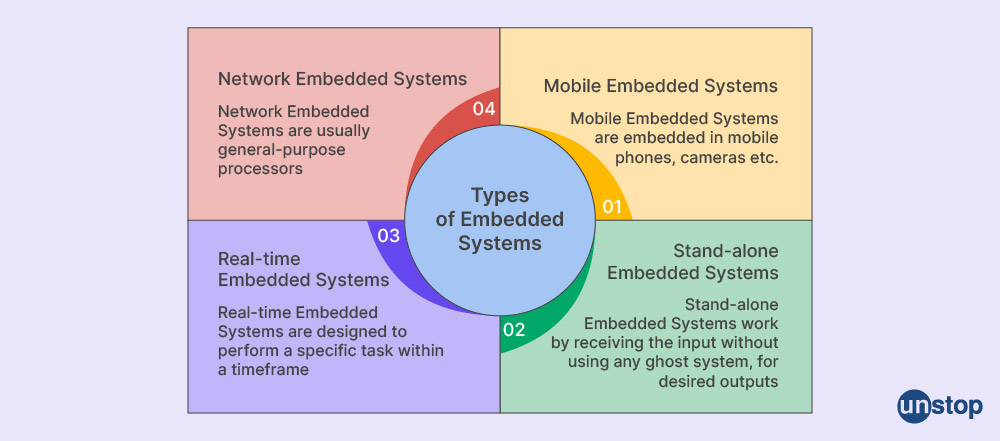
Real-Time Embedded Systems
Real-time embedded systems are computerized devices or machines that use a dedicated microprocessor to perform specific tasks within time constraints. They often respond quickly and accurately to keep track of changing conditions or events as they occur, typically with the help of sensors.
- Real-time embedded systems can be found in everyday products such as car engines, medical equipment, robots, consumer electronics, and home appliances.
- An example of a real-time embedded system is car engine control. This type of system uses sensors to track the performance of the engine. It adjusts parameters (such as fuel injection, spark timing, or air/fuel mix) to ensure optimal operation. The responses must be quick and accurate for an automobile's engine to continue running smoothly without overconsumption or underperformance.
Stand-alone Embedded Systems
Standalone embedded systems are self-contained computing systems designed to perform a specific task without any external input or output.
- They typically comprise a processor, memory, and program code stored in ROM (read-only memory).
- An example is an automotive engine control unit that controls fuel injection speed and timing into cylinders, MP3 players, microwave ovens, digital assistants, and temperature measurement systems.
Networked Embedded Systems
Networked embedded systems are physical devices that contain both computing and networking components. For example, a networked printer is an embedded system containing processors, memory, data storage, software applications, and various peripherals integrated into the same board. In addition, it also has wired or wireless networking capabilities such as Bluetooth or Wi-Fi. Each part of this device works together to ensure that when you press ‘Print,’ your document makes it out on paper.
Mobile Embedded Systems
Mobile embedded systems are computer systems that operate within mobile devices such as smartphones, tablets, and wearables. These systems typically contain both hardware and software components. Examples of mobile embedded systems include:
- A smartphone’s touchscreen display.
- Camera system for taking pictures.
- Wi-Fi connectivity technology for connecting to the Internet wirelessly.
- GPS navigation chips for finding locations on maps and Bluetooth transceivers for communicating with other nearby devices.
Classification Of Embedded Systems Based On Micro-controller/ Complexity
Classification of embedded systems is largely based on the complexity and capability of their microcontrollers. Depending on how complex a task needs to be, several different types of embedded systems are available that use either simple or more powerful microcontrollers.
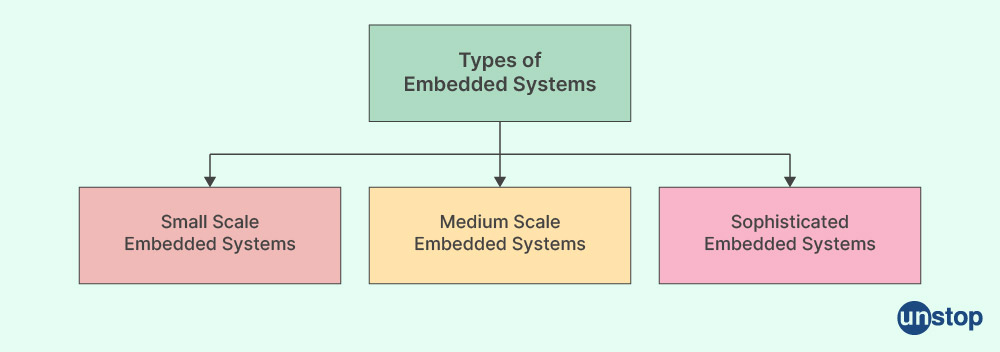
Small Scale Embedded Systems
Small-scale embedded systems are microcontroller-based devices that control and process a variety of electronic components in everyday products.
- They act as the brains behind objects, handling instructions and processes without human aid or intervention.
- Examples include traffic light controllers, security system processors, smart television remote controls, washing machines that select temperatures for you automatically based on what type of fabrics you put into them, etc.
Medium Scale Embedded Systems
Medium-scale embedded systems are electronic devices with a combined hardware and software system designed to perform a dedicated or small set of functions.
Examples of medium-scale embedded systems include handheld computers such as tablets, vehicle electronics such as automotive navigation systems, industrial control systems like robotics controllers, medical equipment such as dialysis machines, etc.
Sophisticated/ Complex Embedded Systems
Complex embedded systems are computer-based systems built into devices that perform specific tasks. These systems interact with the outside environment, including humans and other system components.
An example is an Automated Teller Machine (ATM), which uses an embedded control system to manage customer transactions such as cash withdrawals, deposits, and balance inquiries. The device interfaces directly with customers via hardware components like touch screens, keypads, or card readers while cleverly taking care of all associated software operations in the background.
Classification Of Embedded Systems Based On Generation
Embedded systems have become integral to modern life, as we rely on them to power various electronic devices. The advancement in technology over the years has enabled these small computing platforms to be used for increasingly complex tasks that require more processing power than ever before.
The classification of embedded systems on a generational basis is one way to track this development. There is no doubt that each new generation must have introduced greater capabilities than its predecessor. Let's check it out!
First Generation Embedded Systems (1970-1990)
This includes 8/16-bit processors such as Intel 8086 or Zilog Z8000 CPUs. They featured limited program memory and lacked proper operating systems support. However, they could handle simple tasks like monitoring processes or controlling hardware like motors effectively.
Second Generation Embedded Systems (1980-2000)
This generation of embedded systems had RISC architecture-based microcontrollers such as Motorola 68000 coupled with enhanced RAM capacity.
- This resulted in allowing larger program usage and device drivers for better input-output operation management capability.
- Such controllers also included built-in serial communications ports, including ones supporting the Ethernet protocol stack, enabling external networking connection facilities.
- This led to distributed applications environments where different components could communicate easily via predefined protocols over networks without any modifications.
Third Generation Embedded Systems (1990-2008)
This era is marked by the advanced 32-bit microcontrollers that feature real-time operating systems running on them with larger RAM capacity, resulting in a better development environment for embedded applications.
Notable examples of such controllers include Dallas Semiconductor’s EDU8, ARM7, and TMS320C6x series from Texas Instruments, along with others from Motorola, like the MC68332 and MC9S12 Family.
Fourth Generation Embedded Systems (1998 - Till Date)
During this period, hardware further advanced in processing power, allowing complex algorithms to implement tiny chips, transferring tasks traditionally performed by PCs to these small computing platforms. This made devices more efficient than ever.
- Such processors included the XScale family from Intel along with ColdFire processors having speeds up to 266Mhz.
- They supported open-source distributed software architectures, thus reducing cost without sacrificing performance or scalability.
- And ultimately promised future growth opportunities through an upgradation route whenever needed.
Fifth Generation Embedded Systems (2007 - Present )
This phase saw the integration of powerful dual-core processors like Intel Core Duo taking over where single cores were left out.
- These dual-core processors enabled concurrent execution features leading to multi-threading capabilities supported by the latest version of mobile OSes like Android & iOS.
- They also enabled low power consumption with better clock speeds.
- Such controllers have integrated graphics processing units and wireless & sensor fusion modules to provide a more enhanced user experience.
- Lastly, they were also more cost-effective in terms of energy usage in comparison to previous generations.
Sixth Generation Embedded Systems (2020 - Present)
This includes the latest age of processors such as Intel Atom, ARM Cortex-A, and Qualcomm Snapdragon, which are capable of providing much superior performance than ever before in terms of speed, memory capacity, efficiency, and energy savings.
- All these benefits make them ideal candidates for a variety of applications ranging from robotics to autonomous systems, among others, where they can be used effectively depending upon specific requirements.
- These processors also include support for artificial neural networks, allowing machines autonomous operation capabilities without any intervention required by developers or users alike, thereby revolutionizing automation.
Classification Of Embedded Systems Based On Deterministic Behavior
Embedded systems are designed to complete specific tasks and function within a larger system. They can be found in everyday items such as phones, watches, cars, and other electronics. Embedded systems vary greatly in terms of their capability depending on the application it is used for. These differences can lead to a classification of embedded systems on the basis of their behavior or design characteristics.
In this sense, one way to classify embedded systems is based on deterministic behavior, which the industry has widely accepted due to its simplicity and product standardization.
Hard Real-time Embedded system
Hard real-time systems must guarantee that all deadlines are met without compromising safety or performance, regardless of any external disturbances like events from outside sources or changing environmental conditions.
An example could be an aircraft controller/autopilot requiring decisions much faster than human reaction times with limited room for errors.
Soft Real-time Embedded systems
Soft real-time embedded requires responses at regular intervals but also allows some level of lateness while sacrificing some quality (such as low priority). This type of system would make sure things get better over time, even if there were delays initially.
Examples include streaming video monitors where latency may not have major repercussions unless big enough lags happen continuously over time.
Classification Of Embedded Systems Based On Triggering Mechanism
Embedded systems can be classified according to the triggering mechanism used. The two main types of embedded systems based on this are- event-triggered and time-triggered.
Event-Triggered Embedded Systems
An embedded system designates certain events within its operational environment as triggers. These events can be user commands or data transfers from one location to another within the system. Or they could be other activities directly related to the system's operation and applications.
- Events triggering mechanisms allow designers flexibility in controlling their systems' operations because a specific timing tick rate for tasks does not limit them.
- This triggering may also accommodate changes in workloads without requiring updates or reconfigurations of existing programs due to changing environmental conditions such as temperature variations.
- Event-triggered systems use process scheduling techniques like Round Robin Scheduling, Priority scheduling, etc.
Time-Triggered Embedded Systems
Time-triggered embedded systems establish certain intervals at which all computer operations occur. The processor will execute tasks according to these explicit time frames regardless of any input in the program.
- Unlike event-driven designs, this approach does not respond immediately when an event occurs.
- It instead executes all activities based on predetermined schedules assigned at initialization.
- They are best suited where exact timings are critical, such as automotive safety protocols (e.g., brakes).
- With this approach, hardware design must be consistent with software instructions since both depend upon precise timing signals implemented via real-time clock circuits connected between two chips called Networked Interface Cards (NICs).
- The NIC enables communication between multiple processors and devices in a network.
How Do Embedded Systems Work?
Embedded systems typically consist of a processor, memory, and the necessary input/output (I/O) devices to provide the desired functionality.
- The microprocessor controls or processes data according to instructions from software programs stored in memory.
- This information can be transferred between components using simple serial communication protocols such as I2C and SPI.
- In addition, embedded systems often include specialized hardware for tasks like analog-to-digital conversion and real-time clock functions, which help with accuracy within tight timing constraints.
- Finally, many external peripherals allow applications access to additional physical inputs or outputs such as sensors, actuators, displays, or wireless interfaces.
- These are connected via dedicated ports on the CPU board itself or through an expansion bus that connects multiple peripherals simultaneously (e.g., USB).

Advantages & Disadvantages Of Embedded Systems
The most common advantages of the embedded systems are as follows:
- Low power consumption and low cost due to the integration of components on a single chip make embedded systems suitable for use in consumer electronics products.
- High reliability: Since most embedded systems are designed to be used in harsh operating environments such as extreme temperatures, shock, vibration, dust, etc., they have increased durability compared with general-purpose computers.
- Robustness: Embedded devices can withstand different environmental conditions like high-temperature extremes or air pressure changes without any significant interruption of their working capability, providing better robustness than that offered by traditional computer systems, which require fans for cooling them down when exposed to conditions outside the normal temperature range requirements.
- Versatility: They come in various sizes ranging from small microprocessors found inside cell phones up to large complex processor boards controlling nuclear reactors, so there is no limitation on how much functionality an application may provide if it requires more hardware than adding additional resources available through customized chipsets or specific board designs depending upon what type of system you need.
Listed below are some disadvantages of the embedded systems:
- Dependence on external memory devices makes retrieving data difficult when batteries die out, or another power failure occurs during operations.
- Limited flexibility due to hardwired programming features, making it less user-friendly.
- High complexity in design and programming increases the chance of errors, leading to malfunctioning systems. This makes repair/upgrade difficult or impossible without replacing entire embedded systems.
- Compared to general-purpose computers, small computing power results in poor performance when running high-end applications.
Applications Of Embedded Systems
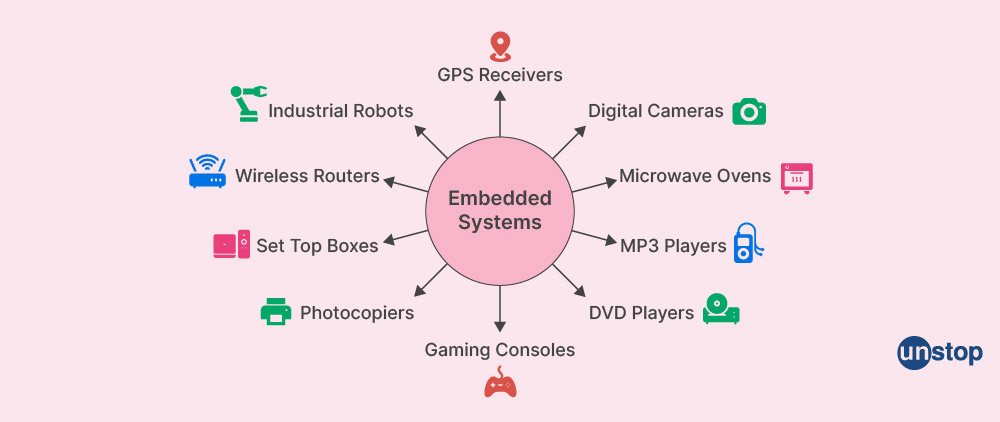
Embedded systems are present in all segments of our lives and are an integral part of our world. Here are some of the most prominent applications of embedded systems:
- Automotive- Engine control units, steering controls, braking systems, infotainment displays, self-parking assistance systems.
- Industrial and Manufacturing Processes- Robotics and automation controllers (PLCs), telemetry monitoring systems, SCADA, security access systems, quality control checkers, and asset management trackers.
- Home/ Consumer electronics- Smart TVs, remote controls with advanced features, e.g., Amazon FireTV Stick or Roku streaming media players, wearable fitness trackers like Fitbit Charge 2/Garmin Vivoactive 3 Music, audio amplifiers & visualizer, voice assistants like Alexa from Amazon or Google Home.
- Healthcare- Diagnostic equipment such as X-ray machines, ultrasound scanners, ECG monitors, medical devices such as pacemakers, surgical robots, etc.
- Aerospace- Navigational guidance systems for aircraft and spacecraft, including Missiles, air traffic control instruments, and fuel injection controllers in jet engines.
- Telecommunications- Network routers, switches, modems, other telecommunication equipment (like mobile phones), and consumer electronic products.
- Defense Systems- ICBM (Intercontinental Ballistic Missile) Launchers, radar systems & early warning equipment such as SONARs (Sound Navigation And Ranging), etc.
Embedded System vs. Server vs. Workstation
|
Aspect |
Embedded System |
Server |
Workstation |
|
Purpose |
Task-specific and dedicated to a single function or set of functions. |
Centralized computer system providing services or resources to other devices/ users. |
High performance designed for demanding tasks, used by professionals for engineering, etc. |
|
Functionality |
Limited functionality tailored to perform specific tasks efficiently. |
Extensive functionality supporting multiple users and diverse applications simultaneously. |
High-end computing capabilities for complex tasks like 3D rendering, simulations, and data analysis. |
|
Size |
Compact size, i.e., it is often small in size. |
Typically, larger and rack-mounted data centers. |
Larger than embedded systems but smaller than servers can be tower/rack mounted. |
|
Processing Power |
Moderate to low processing power. |
High processing power that can handle numerous concurrent tasks. |
High processing power optimized intensive computing tasks. |
|
Connectivity |
It can be connected to other devices or systems, but only sometimes required. |
Designed to be connected to a network and provide services to other devices. |
Connected to a network and may have additional ports for peripherals and expansion. |
|
Operating System |
It may or may not use an operating system and often uses real-time operating systems (RTOS). |
Runs full-fledged operating systems like Windows Server, Linux, or macOS Server. |
Runs standard operating systems like Windows, macOS, or Linux. |
|
Reliability |
High reliability is crucial for critical tasks, often designed for robustness and resilience. |
High reliability to ensure continuous service availability. |
Reliability is important for professional tasks but not as stringent as embedded systems. |
|
Customizability |
Typically limited customizability due to the dedicated nature of tasks. |
It can be customized extensively to suit various applications in services. |
Customizable to meet the performance requirements of specific professional tasks. |
|
Examples |
Smart home devices, automotive systems, industrial automation. |
Web servers, database server file Servers. |
3D modeling workstations, video editing workstations, CAD/CAM workstations. |
Conclusion
Embedded systems are an essential part of everyday life, and their applications range from consumer electronics to aerospace. They come in many forms with different performance and functional requirements depending on their purpose. This leads to a variety of bases on which the classification of embedded systems can be done.
The microcontroller at the heart of the system can be either simple or more complex. The task of information exchange between embedded elements is commonly achieved through serial communication protocols like I2C/SPI.
Additionally, these devices may use various triggering methods, such as time & event-based scheduling, for maximum efficiency within real-time constraints. With this flexibility available for designing varying levels of complexity suitable for any application requirement, it’s no surprise that embedded systems have become pervasive across all industries today!
Frequently Asked Questions
Q. What is an embedded system?
An embedded system is a combination of computer hardware and software designed to perform specific tasks within power, cost, and size constraints. Embedded systems can be found in consumer products such as washing machines, smartphones, medical devices, industrial applications like control systems for manufacturing facilities, robotics, or even aerospace-related avionics systems.
Q. How are embedded systems classified?
The classification of embedded systems can be done on the basis of their capabilities, such as their processor type (configurable processors vs. fixed instruction set), number of connected devices (stand-alone vs. networked), or complexity (simple standalone single board computers up to flight control systems with complex hardware). Other criteria for classification include memory limitations, power dissipation requirements, real-time objectives, and source code engineering tool support.
Q. How are embedded systems classified on the basis of networks?
Embedded systems can broadly be classified into two types on the basis of the networks. The first is an independent systems type (standalone) operating with limited external interactions. The other is the connected network type, which operates within a larger complex environment that may interact with each other over communication networks depending on the application’s requirements.
Q. What are the complexities involved in using an embedded system?
Using an embedded system involves dealing with complexities such as:
- Managing time deadlines for the completion of processes due to limitation of memory capacity and processing speeds available.
- Understanding and handling basic limitations when adopting high-performance real-time operating systems.
- Acquisition systems/control/telemetry solutions involving distributed intelligence across elements connected through networks while also taking into account safety regulations associated with linkages between multiple sources/destinations, etc.
- Need for proper testing and validation processes before deployment, which must comply with industry-wide accepted standards.
Q. Which technologies are used by modern-day embedded systems?
Modern-day embedded systems utilize technologies like real-time operating systems, high-performance computing techniques, communication protocols, and other networking technologies to enable distributed control of connected elements in the system.
Q. How can an organization benefit from deploying embedded systems?
Organizations widely deploy embedded systems within their processes so they can improve efficiency by automating certain manual tasks.
- This allows the resources to be utilized more effectively, thus saving cost and time.
- It also grants better control over different aspects related to operation process accuracy that would otherwise require manual interventions, leading to errors/discrepancies caused due incorrect handling procedures.
Q. Describe the role of different microcontrollers in the classification of embedded systems.
Embedded systems can be classified based on the type of microcontroller used and its purpose. The strength of the microcontroller can be determined by the bit, amongst other things.
- For example, 8-bit microcontrollers are usually used for basic applications such as gaming with small memory requirements and simple input/output capabilities like LEDs or LCDs.
- The 16-bit microcontrollers offer more features than 8-bit but require more power, making them suitable for complex tasks such as multimedia apps.
- The 4-bit controllers, on the other hand, need less power but provide limited features due to their lower performance level and smaller instruction sets. These processors are often seen in smart meters or smart cards where cost efficiency is the key factor over the quality display output capability or processing speed.
- Finally, the 32-bit multi-core processors support multiple threads at once. This makes them suitable for real-time operating systems with multiple users interfacing simultaneously with RTOS (Real Time Operating System).
- For example, data centers use fairly powerful 32-bit microprocessor chips so that they can run operations faster when compared to traditional ones using single-core configurations.
This compiles our discussion on the classification of embedded systems and their application. You might also be interested in reading the following:
- Difference Between Encoder And Decoder Explained!
- Difference Between Static And Dynamic Memory Allocation (With Comparison Chart)
- Functional Units of Computer: Decoded and Explained
- What Is The Difference Between Procedural And Object-Oriented Programming?
- What Is The Difference Between HTML and CSS?
An economics graduate with a passion for storytelling, I thrive on crafting content that blends creativity with technical insight. At Unstop, I create in-depth, SEO-driven content that simplifies complex tech topics and covers a wide array of subjects, all designed to inform, engage, and inspire our readers. My goal is to empower others to truly #BeUnstoppable through content that resonates. When I’m not writing, you’ll find me immersed in art, food, or lost in a good book—constantly drawing inspiration from the world around me.
Login to continue reading
And access exclusive content, personalized recommendations, and career-boosting opportunities.
Subscribe
to our newsletter
Blogs you need to hog!

This Is My First Hackathon, How Should I Prepare? (Tips & Hackathon Questions Inside)

10 Best C++ IDEs That Developers Mention The Most!

Advantages and Disadvantages of Cloud Computing That You Should Know!














Comments
Add comment